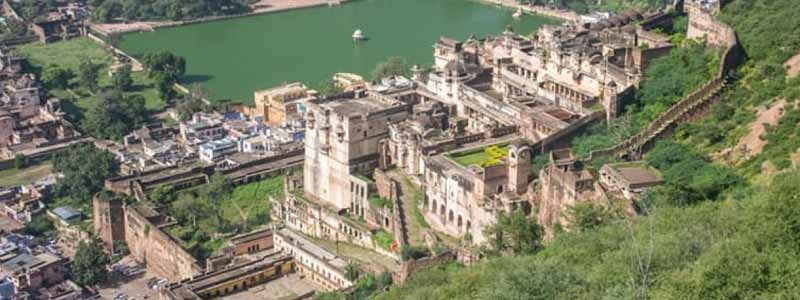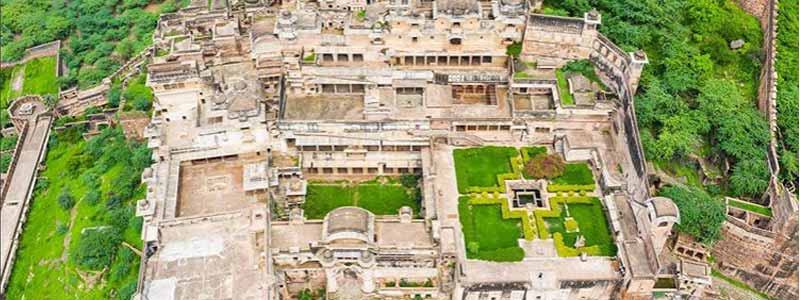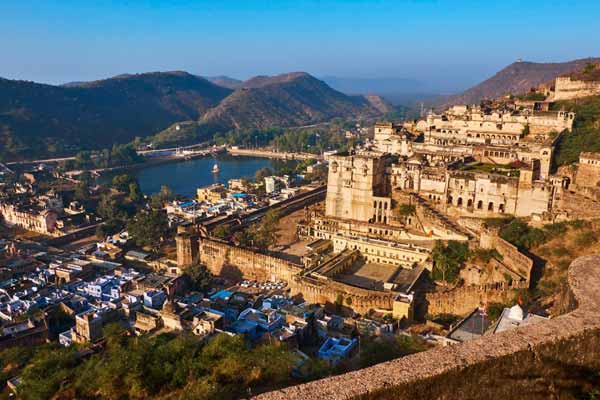Bundi Fort (Taragarh Fort) or Star Fort is situated in the city of Ajmer in the state of Rajasthan, India. It is a massive fort in Bundi and built at a height of 500 meters on a hill by Rao Singh Bar in the 13th century under the reign of King Ajaypal Chauhan. Built in 1354 AD, although the fort is now in a ramshackle state, the Taragarh Fort still remains one of the most impressive forts in Rajasthan. It is built on a steep hill and now is overgrown by vegetation.
Unlike most forts in Rajasthan which are made of Sandstone the Taragarh Fort is made of serpentine stone which is green in colour. It remains one of the few forts in Rajasthan which does not show influences of Mughal style of art and architecture Bundi Fort.

History of Taragarh Fort (Bundi Fort) Rajasthan
Later, Napa Hada, the grandson of Dev Singh Hada, expanded his area, and in 1342 AD, he built a quadrangular fort on the peak of the Aravali mountain which is called Taragarh fort Bundi,
Taragarh means the palace of stars, the hill On seeing this fort looks like a star, hence its name was Taragarh It is said that a ceremony full of joy had become blood pigmented in Taragarh fort Bundi, the daughter of Rao Bir Singh Hada of Bundi was about to be married to Maharana Kheta, during that time, the kul Pandit of Mewar insulted Rao Beer Singh Hada.
He gave the donation reject by them, saying that they accept donations from Rajputs only. Rao Lal Singh, insulted by Hada Kula, was not able to bear his anger and got his sword on Brahmin, the anger of Lal Singh Hada was not seen by Maharana Kheta on his total priest and he returned to Mewar without marriage Rajasthan Budget Tours.
From this festival of Taragarh fort, two Arthii were replaced by the bride’s dolly. The sweet relations with Mewar became toxic, when the relations with Mewar worsened, the robbers of Gujarat and Malwa started robbing this Bundi Fort principality.

Architecture
The Taragarh Fort is an impressive structure made to suit the needs of the people inside when under siege. Lakshmi Pol, Phuta Door and Gaugudi Gate are the three doorways which serve as entrances to the Taragarh Fort. The Gaugudi Gate has a massive and interesting lock and the gate can only be crossed by an entrance way. The once impressive gateways are, for the most part, in ruins. Bundi Fort During its glorified days, Taragarh Fort was well known for its tunnels which run in a criss cross pattern along the entire hillside.
However, these tunnels remain inaccessible because there are no proper maps available. There are several bastions around the fort out of which Bhim Burj is the largest. It is said that there was a massive canon placed here which when fired produced a sound that was akin to thunder that came from the earth. Therefore, it was called the Bhim Burj, which means “Thunder from the Womb’. Such was the power of the canon that it was able to shake the earth Bundi Fort.
Another bastion, called the Chauhan bastion has some deep-water reservoirs. These reservoirs are huge enough to store big amounts of water so that it can be supplied to the residents during time of crisis like a siege which could go on for days and months.
There are a couple of mahals (palaces) inside the fort complex and a probable baradar. The complex also has a palace called the Rani Mahal and is built for the wives and concubines of rulers. The Mahal has lost much of its charm as the shine of its spectacular murals on its walls and the paintings on the stained-glass windows have completely lost its shine and colour. The fort also has Miran Saheb ki Dargah. He was the governor of the fort and died during a siege, in 1210.Taragarh or Dudha Mahal which is situated inside the fort has beautiful frescoed walls. It, like most of the Fort has lost its shine and colour.
The trek is a steep slope and requires walking. Be sure you come with a good pair of shoes or boots and plenty of water. The Map is important to navigate the ground of the fort. There are monkeys and other wild flora and fauna that are present. The top of the hill provides you with a view of the entire city of Bundi Fort. You can smell the freshness in the air feel in the wind in your face. One advice to travellers is to wear comfortable shoes as you’ll have to walk a lot and to bring your own bottles of water.
Best Time to Visit-
Usually, the months of October-March are best suitable for a visit to the Taragarh Fort. These months of winters will save you from the scorching summer heats of April-June and the monsoons of July- September and would help you to explore the place with full enthusiasm.
ATTRACTIONS & PLACES TO VISIT AND EXPLORE IN BUNDI
The tourist attractions in Bundi include glorious medieval forts, temples, havelis and magnificent palaces. The tourists will love to visit Bundi because of its serene atmosphere and strikingly expressive landscape. Bundi Fort is perfectly located at the foothills of a large hill with a splendid lake in the center of this beautiful city of Rajasthan.
Sukh Mahal
Sukh Mahal, a small, two-storied palace was a summer retreat of past rulers. Today, it is quite famous for being the place where Kipling wrote ‘Kim’. Many credit the palace as a having played muse to the renowned novel. In fact, part of a movie based on the novel was even shot here.
Kshar Bag
Located near the Chhatra Vilas Garden, Kshar Bag, sometimes known as Saar Bagh, houses the memorial cenotaphs of the royal family of the Bundi state. It is located on the Shikar Burgh Jait Sagar Road.
Raniji ki Baori
Raniji ki Baori, also known as ‘Queen’s Stepwell’, is a famous stepwell built in 1699 by Rani Nathavati Ji, the younger queen of the ruling king Rao Raja Anirudh Singh of Bundi. This multi-storied stepwell displays excellent carvings of Gajraj with his trunk turned inwards, giving the impression of having drunk from the baori on its pillars. Its high arched gate gives it an inviting appearance.
Dabhai Kund
Shaped like an inverted pyramid, the Dabhai Kund, also known as Jail Kund, is the largest of its kind in Bundi. The fantastic carvings on the steps that lead to the water alone are reason enough to warrant a visit.
84 Pillared Cenotaph
As the name suggests, the 84 Pillared Cenotaph is a structure supported by 84 columns. Commissioned by Rao Anirudh, the Maharaja of Bundi, this cenotaph is a tribute to his beloved wet nurse, Deva, who he loved dearly. A popular tourist attraction, this impressive structure is decorated with carvings of deer, elephants and apsaras.
Garh Palace Bundi
The Garh Palace in Bundi Fort is counted among the largest palaces in India, even if it is a little less known. Inside, the palace is a collection a number of palaces that were built by different rulers over the span of 3 centuries. Garh Palace is known for its Rajput architecture, which is easily noticeable in the jharokhas and pillars, many of which sport elephant carvings.
Some of the famous palaces here include Chhatra Mahal, Phool Mahal and Badal Mahal, but one of the most famous ones has to be the Chitrashala, which has a fascinating pavilion and gallery of miniature murals. The palace is open to visitors from 8.00 am in the morning till 5.00 pm in the evening. Bundi Fort There is a small entry fee that has to be paid, and one has the option to hire a guide who can take you through the stories and history of this beautiful palace.
